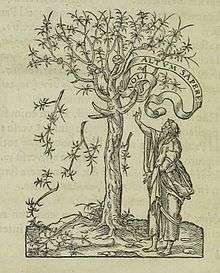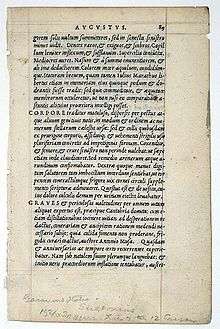Robert Estienne

Robert I Estienne (French: [etjɛn]; 1503 – 7 September 1559), known as Robertus Stephanus in Latin[1] and also referred to as Robert Stephens by 18th and 19th-century English writers, was a 16th-century printer and classical scholar in Paris. He was a former Catholic who became a Protestant late in his life and the first to print the Bible divided into standard numbered verses.
Life


Robert was born in Paris, the second son of the famous humanist printer Henri Estienne (the Elder). He became acquainted early on with ancient languages. After Henri's death in 1520, the printing establishment was maintained by his former partner Simon de Colines who also married Robert's mother, the widow Estienne. In 1526 Robert assumed control of his father's printing shop while de Colines established his own firm nearby.[2][3]
In 1539 Robert adopted as his device an olive branch around which a serpent was twined, and a man standing under an olive-tree, with grafts from which wild branches were falling to the ground, with the words of Romans 11:20, Noli altum sapere, sed time ... ("Be not high-minded, but fear"). The latter was called the olive of the Stephens family.
In 1539 he received the distinguishing title of "Printer in Greek to the king". But the official recognition and the crown's approval to his undertaking could not save him from the censure and ceaseless opposition of the divines. In 1550, to escape the violence of his persecutors, he emigrated to Geneva, where he set up his printing house.
With his title of "royal typographer" Estienne made the Paris establishment famous by his numerous editions of grammatical works and other schoolbooks (among them many of Melanchthon's) and of classical and Patristic authors, such as Dio Cassius, Cicero, Sallust, Julius Caesar, Justin, Socrates Scholasticus, and Sozomen. Many of these, especially the Greek editions (which were printed with typefaces made by Claude Garamond), were famous for their typographical elegance. The editiones principes which issued from Robert's press were eight in number, viz. Eusebius of Caesarea (including the Praeparatio evangelica and the Demonstratio evangelica, as well as the Historia ecclesiastica) (1544–1546), Manuel Moschopulus (1545), Dionysius of Halicarnassus (February 1547), Alexander of Tralles (January 1548), Dio Cassius (January 1548), Justin Martyr (1551), Xiphilinus (1551), Appian (1551). The last was completed, after Robert's departure from Paris, by his brother Charles and appeared under his name. These editions, all in folio, except the Moschopulus, which is in quarto, are unrivalled for beauty. Robert also printed numerous editions of Latin classics, of which perhaps the folio Virgil of 1532 is the most noteworthy. He printed a large quantity of Latin grammars and other educational works, many of which were written by Maturin Cordier, his friend and co-worker in the cause of humanism.

In 1532 he published the remarkable Thesaurus linguae latinae and twice he published the entire Hebrew Bible—"one with the Commentary of Kimchi on the minor prophets, in 13 vols. 4to (quarto) (Paris, 1539-43), another in 10 vols. 16mo (sextodecimo) (ibid. 1544–46)."[4] Both of these editions are rare.
Of more importance are his four editions of the Greek New Testament, 1546, 1549, 1550, and 1551, the last in Geneva. The first two are among the neatest Greek texts known, called O mirificam. The third, a splendid masterpiece of typographical skill, is known as the Editio Regia. The 1551 edition contains the Latin translation of Erasmus and the Vulgate, is not nearly as fine as the other three, and is exceedingly rare. It was in this edition that the division of the New Testament into verses was for the first time introduced.
A number of editions of the Vulgate also appeared from his presses, of which the principal are those of 1528, 1532, 1540 (one of the ornaments of his press), and 1546. His editions, especially that of 1546, containing a new translation at the side of the Vulgate, was the subject of sharp and acrimonious criticism from the clergy.
On his arrival at Geneva, he published a defense against the attacks of the Sorbonne. He issued the French Bible in 1553 and many of John Calvin's writings, including the finest edition of the Institutio in 1553. His fine edition of the Latin Bible with glosses (1556) contained the translation of the Old Testament by Santes Pagninus and the first edition of Theodore Beza's Latin edition of the New Testament.[5] He died in Geneva.
Sons
Three of Robert's sons, Henri, Robert, and François, became celebrated as printers. François (b. 1540) printed on his own account in Geneva from 1562–1582, issuing a number of editions of the Bible in Latin and French, and some of Calvin's works. French writers identify him with a printer by the name of Estienne in Normandy, to which he is supposed to have emigrated in 1582.
Robert Estienne Jr. (1530–1570) began to print in Paris on his own account in 1556, receiving the title of Typographus regius in 1563. His presses were busily employed in issuing civil documents. He held to the Catholic faith and thus won the support of Charles IX. By 1563 he appears to have fully reconstituted his father's establishment in Paris. His edition of the New Testament of 1568–1569, a reprint of his father's first edition and equal to it in elegance of execution, is now exceedingly rare.
See also
Notes
- ↑ Philippe Renouard, Répertoire des imprimeurs parisiens, Paris 1926, reprint 1965, pp. 141–143.
- ↑ Renouard, Répertoire, p. 142.
- ↑ "Simon de Colines". Encyclopædia Britannica. Encyclopædia Britannica Online. 2009.
- ↑ M'Clintock, John and Strong, James (1880) Cyclopaedia of Biblical, Theological, and Ecclesiastical Literature. Vol. IX, s.v. "Stephens" New York: Harper & Brothers. The commentator is David Kimhi (Hebrew: דוד קמחי, also Kimchi or Qimḥi).
- ↑ Martin, H.-J. (1982) "Le temps de Robert Estienne, in his Histoire de l'édition française, vol. 1, Paris, 1982, pp. 230–235.
Sources
- Martin, Henri-Jean (1982) « Le temps de Robert Estienne », Histoire de l'édition française, vol. 1, Paris, pp. 230–235 ISBN 2-903181-06-3
- Schreiber, Fred (1982) The Estiennes: an annotated catalogue of 300 highlights of their various presses. New York: E. K. Schreiber
![]() This article incorporates text from a publication now in the public domain: Jackson, Samuel Macauley, ed. (1914). "article name needed". New Schaff–Herzog Encyclopedia of Religious Knowledge (third ed.). London and New York: Funk and Wagnalls.
This article incorporates text from a publication now in the public domain: Jackson, Samuel Macauley, ed. (1914). "article name needed". New Schaff–Herzog Encyclopedia of Religious Knowledge (third ed.). London and New York: Funk and Wagnalls.
-
 This article incorporates text from a publication now in the public domain: Chisholm, Hugh, ed. (1911). "article name needed". Encyclopædia Britannica (11th ed.). Cambridge University Press.
This article incorporates text from a publication now in the public domain: Chisholm, Hugh, ed. (1911). "article name needed". Encyclopædia Britannica (11th ed.). Cambridge University Press.
External links
| Wikimedia Commons has media related to Robert Estienne. |
- Exemplaires numérisés d'anciennes éditions d'œuvres de Robert Estienne sur le site des Bibliothèques virtuelles humanistes
- Robert Estienne sur le Musée virtuel du protestantisme français.
- Alphabetum Græcum From the Rare Book and Special Collections Division at the Library of Congress